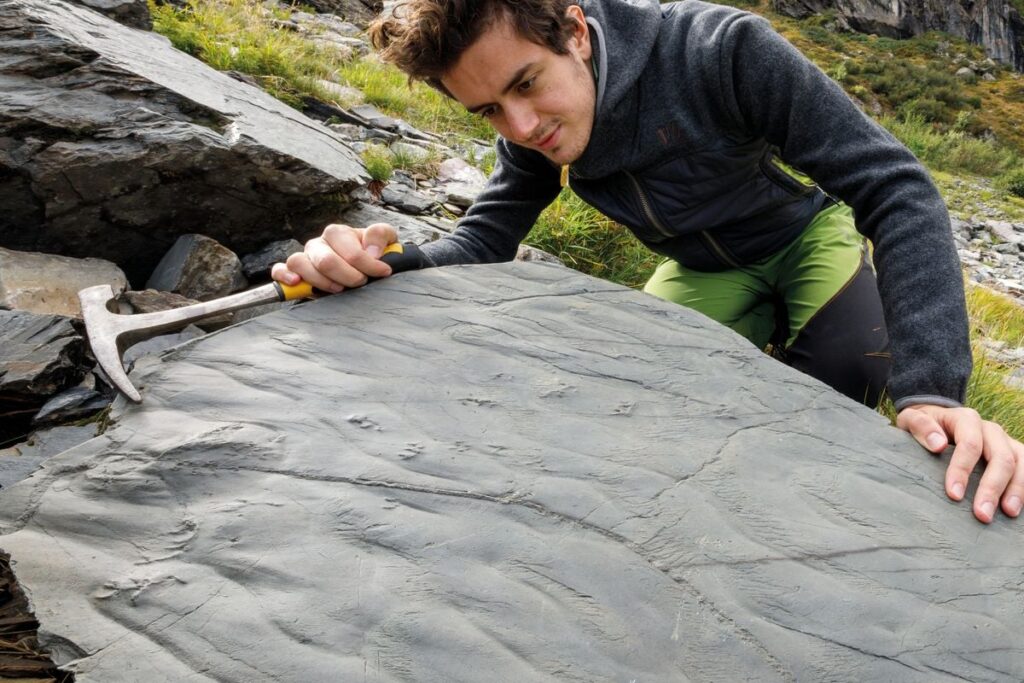This rock contains the first of the newly discovered fossils: It is a portion of a fossil lake shore that preserves very fine details of ripples produced by waves, on which a small reptile left behind footprints of its legs and tail.
Elio Della Ferrera / Superintendence of Archaeology, Fine Arts and Landscape of the provinces of Como, Lecco, Monza-Brianza, Pavia, Sondrio and Varese
On a hot summer day last year, Claudia Steffensen and her husband embarked on a hike through a rocky trail in the Italian Alps. As they made their way down the mountain, Steffensen was looking down at her feet as her husband walked ahead. When she took a step forward, she noticed strange circular designs on a rock.
“I took a closer look and realized they were footprints,” Steffensen, from Lovero, Italy, tells the Guardian’s Angela Giuffrida.
The indentations turned out to be the footprints of reptiles and amphibians from the Permian period, which spanned from 251 million to 299 million years ago. Uncovered by melting ice and snow, the footprints offer a clue to what researchers suggest was an entire prehistoric ecosystem.
Steffensen’s discovery, before being made public last week, was brought to the attention of scientists at museums and universities. They mapped out the area and revealed even more fossilized footprints, uncovering tracks that belonged to at least five different animal species from before the time of the dinosaurs, per the Guardian.
For one of the researchers, Lorenzo Marchetti, a paleontologist at Berlin’s Museum of Natural History, this one seemed the most “rich” out of all the Permian sites he had studied in the area, he tells NBC News’ Hannah Peart. He was “amazed by the quality and quantity of the material.”
The prints were made during a time when the sandstone and mud was soaked with water. Later, the ground dried up in the heat of the sun, and when water returned, it formed a protective clay-like layer over them, says Ausonio Ronchi, a researcher at the University of Pavia in Italy, in a statement.
Now, the petrification of the very fine grain in these sediments has allowed for some “impressive conservation of details,” Marchetti adds in the statement, “like the imprint of some animals’ fingertips and belly skin.”
A large rock with footprints of four-legged tetrapods (in this case, amphibians and reptiles) lined up to form “tracks.”
Elio Della Ferrera / Superintendence of Archaeology, Fine Arts and Landscape of the provinces of Como, Lecco, Monza-Brianza, Pavia, Sondrio and Varese
The Permian period, the last part of the Paleozoic Era, ended with the largest mass extinction in the history of life on Earth. Often called the Great Dying, this event transformed many ecosystems, killing off roughly 70 percent of land species and 90 percent of marine species. Afterward, new life forms started to dominate, beginning what is called the Age of Dinosaurs.
Although dinosaurs did not yet exist when the footprints on the rocks occurred, “the authors of the biggest prints discovered here had to nevertheless have notable dimensions—up to two to three meters in length,” says Cristiano Dal Sasso, a paleontologist at the Natural History Museum in Milan, in the statement.
The discovery was made possible by the disappearance of last year’s ice in the site, prompted by climate change, the researchers say. Throughout the Alps, warming temperatures have decreased the sizes of snow-covered zones that reflect the sun’s rays. When the snow melts, it exposes rocks and vegetation that absorb more of the sun’s heat and further contribute to melting.
These uncovered areas also make it possible to find fossils. As a consequence of cracking and erosion, blocks of rock fall down the walls, “so we expect to find many more tracks and fossils in the coming years,” says Ronchi to Sports Illustrated’s Maria Aldrich.
Researchers pack the samples with spongy material to protect the fossils.
Elio Della Ferrera / Superintendence of Archaeology, Fine Arts and Landscape of the provinces of Como, Lecco, Monza-Brianza, Pavia, Sondrio and Varese
Steffensen’s finds were shown for the first time during a press conference at the Natural History Museum in Milan. They were recovered from the rocky trail and the high altitude through a helicopter airlift.
For the research team, there is not only historical interest in these findings. Although the new site represents an important addition to paleontology, the fossils also testify to a faraway period with global warming similar to today’s, they argue in the statement.
“The past has a lot to teach us about what we risk messing up now, because of us, in the world,” the researchers say in the statement.
As the team continues to research the site, Steffensen says to the Guardian, “I’m feeling very proud, especially to have made a small contribution to science.”


